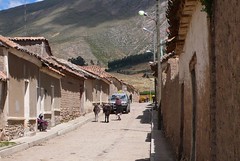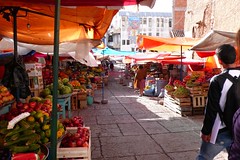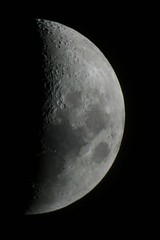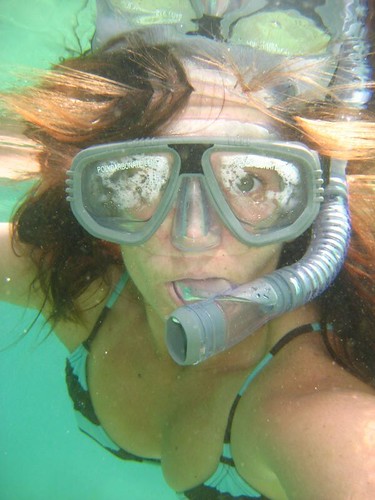These photos are a little delayed, sorry. I've been struggling to upload photos for days - computers keep melting down...
On our last day in Cuzco we took a collectivo out to Tambomachay to visit the Baños del Inka. From there we walked back into town passing the Red Fort (Puka Pukara), Q'enko and finally Sacsayhuamán.
Sacsayhuamán is an impressive Inka site overlooking the City of Cuzco. The scale of the stonework is amazing.
Friday, May 23, 2008
Playing catchup!
Posted by
ladyhedda
at
18:10
0
comments
![]()
Wednesday, May 21, 2008
An all-English final
I was happily sitting on the computer minding my own business when Angelo (sitting on his balcony in Holland) pointed out that the Champions League final had started. I told Michael, who quickly grabbed his coat and was out the door before I could say Arsenal.
We found a bar, with a TV and ordered a jarra of cerveza. The whole of the street was filled with people watching the game. One jarra turned into two, and two turned into four.
Thanks Angelo.
Posted by
ladyhedda
at
21:13
0
comments
![]()
Sunday, May 18, 2008
Heading to Lima
We're on the overnight bus to Lima today - eighteen and a half hours if all runs smoothly. Darrin flies in on Monday, and after a couple of days in Lima we'll be heading to the beach!
Posted by
ladyhedda
at
11:33
1 comments
![]()
Saturday, May 17, 2008
We made it...
After 4 days of walking we made it to our destination, Machu Picchu. We were up early (again) to make it to the top for sunrise and beat the worst of the crowds.
I love the feeling that comes when you have worked hard (and walked hard) to reach a destination. There is something very spiritual about following the paths that people have used for centuries to link villages and cities together.
Posted by
ladyhedda
at
17:32
0
comments
![]()
Salkantay Trek
We were on the bus at 4.30 in the morning headed for the town of Mollepata, and the begining of the trek. In Mollepata we handed over our sleeping bags and other gear to the horsemen, who packed them onto the mules. Mollepata is at 2900m, and our destination for the 1st night was Soraypampa at 3850m. The walking was steady, and the climb gentle in most parts.
As we ate lunch we watched the rain clouds gathering in the valley ahead, behind us was sunshine and blue skies. The first rain came as we pulled into our campground and settled into our tents. We ate dinner all the time watching the weather outside as the temperature gradually decreased.
The next morning we were woken with a cup of mate de coca at 5.30am. In the night the rain had turned to snow. SNOW, on the day that we had to cross the pass. We waited to see if the snow would clear, and when it became aparrant that it was with us for the duration we slipped into our bin liner ponchos and started the climb to the pass.
The initial trail had us gaining elevation quickly, but soon leveled out into a beautiful white valley where we stopped to catch our breath. The trail followed the river and dissapeared ahead of us into the clouds.
The next hour was a constant climb on switchbacks that zig-zaged endlessly. I ended up on my ass as a group of mules came barreling down the trail and tried to take me with them. We took a short break by a lake, a break that involved standing around shovelling biscuits into our faces and trying to stay warm. We built a snowman and talked about making snow angels, but it was too cold to lay in the snow.
After 4 1/2 hours of climbing in constant snow we made it to the pass at 4600m. On the pass our guide lead us in a ceremony to thank the mountain for our safe travels. All of us had carried a stone with us, we held it in our right hand. In our left hand we held a coca leaf. We faced the mountain and (in our best Quechua) said "Thank you Mountain Salkantay". One by one we placed our coca leaves on the ground with the stone on top of them, forming a small cairn. The passes in the Andes are marked by these cairns as travellers bring stones as offerings to the mountains. We had made it to the highest point on our trek. It was time to start heading down.
The trail descended from the pass into Cloud Forest, as we moved further from the pass, the snow turned to rain and the trail turned into a mud bath. The mud was inches deep. The Cloud Forest is beautiful. There are orchids and bromeliads in the trees, the sounds of birds overhead and the squelch of our feet below.
The second camp was in a beautiful valley, the air was warmer and we went to bed feeling warm (if not quite dry) and happy that the hardest day was behind us.
The third day continued through muddy trails in the forest. The rain had ended and given way to bright blue skies. It was a relatively short day (only 14kms) to our camp, and we made it in time for lunch.
In the afternoon I settled into a slow yoga and stretching routine. Michael and the boys decided to play 5 a side with the cooks and our guide. Two hours later Michael returned, cursing himself for getting talked into another game! We slept well.
Our final day of hiking was to take us to our first view of Machu Picchu. The original stones of the Inka trails are impressive and filled us with a sense of purpose. There we were, at an Inka checkpoint looking over the valley at our destination, Machu Picchu.
Posted by
ladyhedda
at
17:11
0
comments
![]()
My legs hurt
We made it! We're back in Cusco after a hike full of fun and plenty of weather. We trekked a total of 70kms, and none of it was flat. If we weren't climbing up snowy passes, we were squelching down muddy jungle trails.
These are Michael's photos. Enjoy!
More to follow soon.....
Posted by
ladyhedda
at
15:52
0
comments
![]()
Sunday, May 11, 2008
We're off on another hike....
We've been debating how to get to Machu Pichu, by train or by trek. The trekking option has won.... So, tomorrow we're up with the birds (probably before the birds) to get a bus to the trail head. We're trekking the Salkantay route, it's supposed to have amazing mountain views (there is one pass to climb over at 4600m) and beautiful jungle sections. We shall see!
We'll be back in Cuzco on Friday night...
Posted by
ladyhedda
at
17:54
0
comments
![]()
Wednesday, May 07, 2008
Isla del Sol
We spent a couple of nights on Isla del Sol, in Lake Titicaca. The weather was perfect, and we spent the time exploring the island and it's communitites.
Isla del Sol is the site of the Inka creation myth. Viracocha, the supreme Inka god, destroyed the area surrounding Lake Titicaca with a Great Flood. After this, his decendants Manco Kapac and Mama Ocllo sprung from the lake to found Cuzco and the Inka dynasty.
Posted by
ladyhedda
at
16:52
0
comments
![]()
Tuesday, May 06, 2008
La Paz Lady...
Landing in La Paz on our tiny plane fresh out of the jungle is a trippy experience. We flew from jungle through mountain passes, where the mountains looked close enough to touch into El Alto airport. The airport is at 4000m in the town of El Alto that is perched above La Paz. The minute you step off the plane you can tell you are at 4000m simply because the backpack feels so heavy, and walking up stairs is much harder than it needs to be. Fortunately we have spent most of the last month above 2800m (much of it closer to 3800m) - so adjusting didn't take long.
The Ladies in Bolivia all wear hats, and some really great hats. But it was in La Paz that I fell in love with their Bowler hats. They balance them effortlessly on their heads. I tried and failed to pull off the look, so we left the Bowler hat in La Paz where it belongs.
Posted by
ladyhedda
at
13:24
0
comments
![]()
Sunday, May 04, 2008
Da Jungle
We just spent a fantastic 3 nights in the Madidi National Park. We decided to stay at the Chalalan lodge, a community owned and operated lodge. The lodge was built with financial aid from Conservation International and the Interamerican Development Bank. It was designed and constructed by the local community (San José de Uchupiamonas) using their traditional materials and techniques.
The lodge situated on the bank of Lago Chalalan, and is reached by a 5 1/2 hour trip up the Beni and Tuíchi rivers, followed by a 20 minute walk through the forest.
Our nights were filled by the sound of nocturnal animals and our days were spent canoing on the lake and walking in the jungle with our guide. The jungle is not the best place for wildlife spotting, as the animals are at home and constantly on the move. If their path and your trail happen to intersect then you are lucky!
On our second day we packed a boxed lunch and set out on a longer walk. We crossed the Rayamayo River (Stingray River), using sticks to prod the river bed and hopefully scare the stingrays away... we arrived for lunch at the Eslabón river where I tried and tried to catch a catfish for my dinner. No luck.
During our trip we were lucky enough to run into an assortment of monkeys (Capuchin, Squirrel, Red Howler and the elusive Black Spider Monkey). We also joined a group of wild Boar eating their way through the forest and an endangered Red Brocket Deer. We saw Toucans, Macaws, Parrots and Parakeets as well as a King Vulture and his friends.
The Madidi National Park is one of the most biologically diverse protected areas on the planet, and is home to over 1000 species of bird (11% of the worlds known avian species). It was created in 1995 and encompasses Amazonian lowlands at 200m, to the mountains of the Apolobamba Range at more than 6000m (19,685ft), including a huge range of wildlife habitats, from torrid rain forests to Andean glaciers.
Ver mapa más grande
Posted by
ladyhedda
at
12:05
0
comments
![]()
Friday, April 25, 2008
Sucre oh Sucre
We have had a really great time here in Sucre. In fact, it's going to go down as one of my favourite cities that we have visited. Our acommodation was just perfect, and at $4 a night who can complain. The coffee at breakfast was not Nescafe, but real proper coffee. We've eaten beautiful fresh produce from the market every day combined with delicious Bolivian chorizo lunches. However, we gotta keep this show on the road....
We're on the night bus tonight to La Paz. It's a short 12 hours, and Michael has secured us seats on the 'Best Bus in Bolivia'... That's right. There is a bus in Bolivia that is better than all of the rest of the busses, and WE ARE ON IT. It remains to be seen what makes this bus better than the rest, but here's a suggestion:
Reclining seats...
Posted by
ladyhedda
at
15:54
0
comments
![]()
Monday, April 21, 2008
I may have to go shopping for clothes
It seems, however, that I may be forced to buy myself a new pair of trousers. The pair I currently have now have a floral patch on the butt, and are promising to wear through in at least 3 other places.
My favorite skirt (yes the one that I wear all the time, in every photo, evidence here, here and here) is also on it's way out. I have already made about 4 repairs to it, and when it returned from the last wash I had to make 3 more.
If these two items die, it will leave me with only one skirt. And that skirt I made by cutting up a dress.
The photo is of Michaels trousers. He retired them, as they were threadbare. Fortunately Ken (Thank you Ken) donated a pair of jeans which means that Michael won't have to resort to shorts and legwarmers.
Posted by
ladyhedda
at
21:10
0
comments
![]()
Fitting right in
On the bus on the way home I was admired by a couple of locals who kept taking my hat off, and putting it back on my head at a 'better' angle. Taking it off again, they even inspected the inside of the hat, and were thrilled to find out that it was a Bolivian original. We compared hat 'notes' in sign language as my Quechua language skills are non existant, and they spoke no Spanish.
Posted by
ladyhedda
at
20:36
1 comments
![]()
Sunday, April 20, 2008
Sunday market
The market itself is famous for it's local indigenous community in traditional dress. You can see a fantastic slide show of the market here, and more photos here. The costumes are so beautiful, and incredibly detailed.
Posted by
ladyhedda
at
19:49
0
comments
![]()
Saturday, April 19, 2008
3-0
Universidad, the local team were playing Oriente and the whole of Sucre had turned out for the match. The stadium was sold out, and the final score of 3-0 (to Sucre) ensured that there were many firecrackers.
We ate hot dogs and joined in the 'mexican wave' and cheered ourselves hoarse...
Posted by
ladyhedda
at
20:10
0
comments
![]()
Shopping for our supper
Posted by
ladyhedda
at
15:07
0
comments
![]()
Tuesday, April 15, 2008
Pass the salt please...
The Salar de Uyuni covers an area of 12,000 km², making it the largest in the world. It's hypnotic, the salt is endless and the horizon wavers in the distance. At it's thickest point the salt is 8m deep.
We dragged ourselves out of bed at 5.30am to watch the sun rise over the salt flats, and then spent the morning driving and walking on the salt. We visited a couple of different 'islands' and had fun scrambling amoungst the cacti.
The day finished in Uyuni, where we visited the train graveyard - where all those hard working trains go to sleep.
Posted by
ladyhedda
at
20:24
0
comments
![]()
Monday, April 14, 2008
The air is thin...
Day 2 on the altiplano. We loaded the car, and set off on another day of surreal landscapes, beautiful wildlife and spectacular scenery.
All of us had struggled to sleep throught the night, not only because of the extreme cold but also due to the altitude.
The second day was filled with expansive landscapes, 'daliesque' desert colours and more altiplano lagunas filled with flamingos.
We finished the day in a salt hotel on the edge of the Salar de Uyuni. Everything in the hotel was made of salt - walls, beds, tables & chairs. Even the floor crunched underfoot!
Posted by
ladyhedda
at
20:19
0
comments
![]()
Sunday, April 13, 2008
Headed into Bolivia...
These are the photos from our first day in Bolivia. We crossed the border at 10 in the morning, where we loaded the surfboards onto a Toyota 4x4 for the trip across the altiplano to Uyuni. The terrain is rough and dusty, and the road (track? trail?) on the bumpy side - but the scenery is out of this world.
It's a fairytale landscape unlike anything we've seen before.
The day included visits to two altiplano lakes and some thermal hot springs. The first lake Laguna Blanca, is home to flamingos and appears white due to the high concentration of borax. We then traveled on to Laguna Verde and the Licancabur Volcano. Laguna Verde has high mineral levels of Arsenic, Lead and Copper giving it a bright green color. Both of these lakes are at 4400m (14,400 ft).
A mid morning visit to the thermal hot springs (Termas de Polques) gave us an excuse for a bath and some time out of the truck. The water was lovely and warm, but getting out was difficult - cold wind and nowhere to get changed made for some fun balancing acts!
After our bath we headed to the Solar de Manaña geyser basin, to watch some bubbling pools of mud spit stinky gas into the air. These are at 5000m (16,400ft) - which left us all a little out of breath, and happy to be back in the truck as passangers with minimal physical exertion!
After lunch we visited Laguna Colorada - a beautiful red lake filled with 3 species of flamingo (James's, Andean & Chilean). The lake is colored red by algae and has bright white borax islands that create a startling contrast.
Our acommodation for the night was in a basic adobe building - no heating, so we pilfered extra blankets from the room next door... All of us slept in our hats as the outside temperature was -15 centigrade (5 farenheit)... (really really cold)
Posted by
ladyhedda
at
20:00
0
comments
![]()
Saturday, April 12, 2008
La Luna
The air over the Atacama desert is transparant and dry, which makes for perfect stargazing.
We watched the moon set and the sky darken. Alain (our astronomer guide) taught us about stars, constellations, planets and galaxies. He has 6 telescopes set up all directed towards different objects. We saw the Moon, Saturn, Mars alongside clusters, gas fields and more.
Michael has written a beautiful post about his experience at an observatory further south over here....
Posted by
ladyhedda
at
13:53
0
comments
![]()







